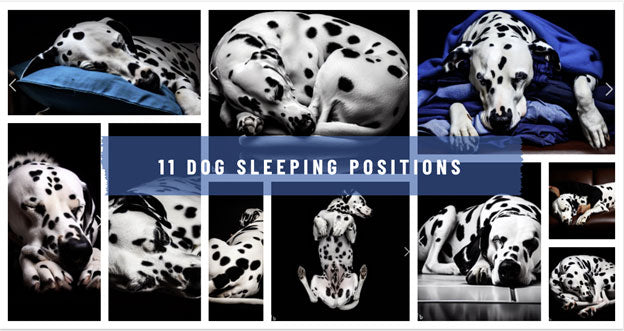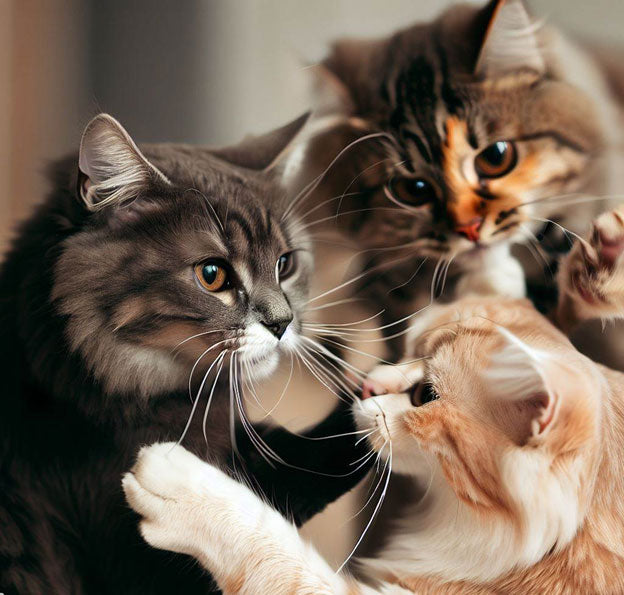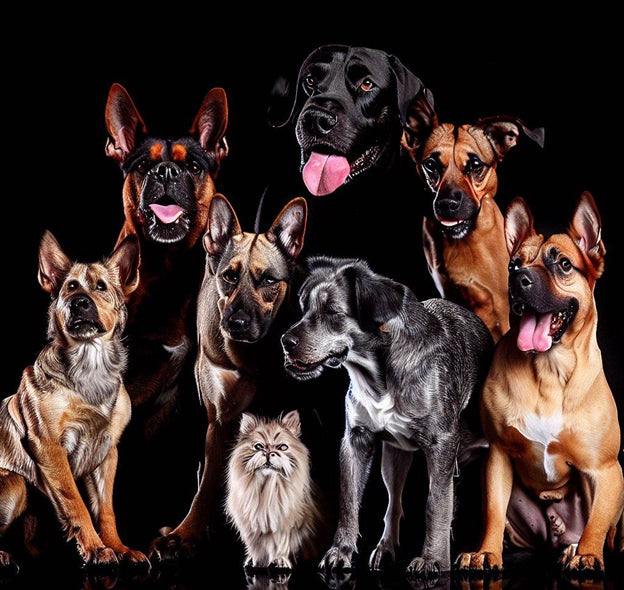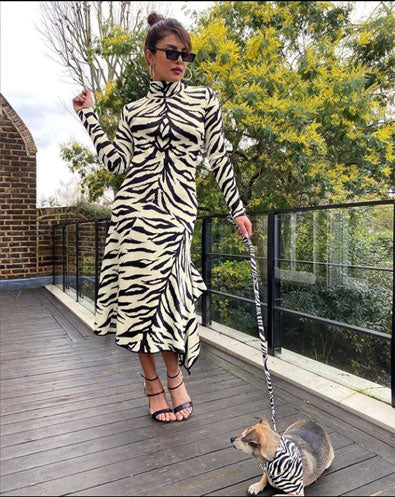
The Language of Sleep: Exploring Dog Sleeping Positions & What They Mean
Disclaimer: Some of the links in our blog posts are affiliate links. This means we may earn a small commission if you make a purchase through them which helps support our blog, at no extra cost to you.
Just like humans, dogs have certain sleep positions that can reveal much about their temperament, behavior, and overall well-being. Our canine companions' sleeping positions provide us with adorable moments of cuteness and offer fascinating insights into their unique personalities. Understanding the correlation between dog sleeping positions and their personalities can help pet owners better understand their furry friends and strengthen their bond. Let's explore the intriguing world of dog sleeping positions and delve into the various personality traits that can be deciphered from these positions. So, get ready to unlock the secrets behind your dog's favorite sleeping pose and discover the hidden dimensions of their captivating personalities.
What do dog sleeping positions mean?
Have you ever noticed your dog sleeping in an unfamiliar position and wondered if it holds any significance? Just like humans, dogs exhibit a diverse range of sleeping positions. Whether they prefer snoozing on their side or stretching out on their back with their paws in the air, these positions can provide valuable insights into our furry companions' well-being and personality.
Join us as we explore our comprehensive dog sleeping positions and uncover the significance behind these postures.
Donut Sleeping Position

Donut Dog Sleeping Position is when your furry baby sleeps curled up like a ball. The "donut position" refers to when a dog sleeps curled up in a compact ball, with all their limbs snugly tucked close to its body. In this position, their nose might touch their hind legs, creating a "shrimp" curl, and they may even drape their tail over their body. The donut position allows dogs to safeguard their vital organs by keeping them tucked and concealed.
A dog sleeping in this position typically indicates their instinct to protect themselves during sleep or adjust to a new environment. This behavior is prevalent among stray or recently adopted dogs.
Furthermore, dogs often adopt the donut position when they feel cold. By curling up tightly, they attempt to conserve their body heat. It is a favored sleeping posture, especially during chilly or windy weather, as it offers protection against the elements, mimicking the shelter they would have sought while sleeping outdoors.
Superman Sleeping Position

The "Superman position" refers to when a dog lies flat on the ground, belly pressed to the floor, with its back legs extended behind them and its front legs stretched forward. This adorable posture, sometimes called a "sploot" is frequently seen in puppies and highly playful dogs.
When a dog sleeps in the Superman position, it signifies that they are exhausted but still eager and prepared to engage in play if given the opportunity. This position allows dogs to doze off while remaining alert and ready to jump up and join any playtime quickly. It is a typical sleeping pose among energetic dogs, especially during the daytime when they have ample energy to burn.
Explore our collection of superhero pet portraits, they are the perfect gift for any pet lover!
Snowball Sleeping Position

The snowball position, often associated with cats, is also quite common among dogs. In this position, a dog curls up with their nose-to-tail, creating a curved spine. It is a favored sleeping position during late fall and winter, allowing dogs to sleep comfortably. The primary reason behind this preference is the heat conservation it provides. However, the snowball position communicates more than just a dog's desire to stay warm and cozy.
Similar to the fetal position in humans, the snowball position suggests a dog's instinct to protect itself. It harkens back to their early days as puppies when they would sleep in dens. Lying tightly curling up, dogs retain warmth and shield vulnerable organs from threats or predators. This sleeping posture is sometimes observed in new dogs or puppies who may feel slightly insecure in their surroundings and are adapting to their environment. It's important to note that your dog may assume this position simply because it feels comfortable and pleasurable.
Pancake or Side Sleeper Position

If your dog is sleeping on its side, appearing flattened and resembling a "Pancake," it indicates it is comfortable. Like the "Dead Bug" position, this exposes their vital systems and makes it challenging to get up quickly compared to other dog sleeping positions. Sometimes, dogs may seek support from an object like a wall or a chair to enhance their security in this vulnerable position, creating a safe and protected environment. This sleeping posture may also suggest that your dog is in a deep slumber and should not be disturbed, as they are likely experiencing the restorative REM stage of sleep. They might even be dreaming! Observing your dog howling or kicking signifies that they are in a deep sleep and physically acting out their dreams or nightmares. If they wake up from this state, give them a comforting embrace and reassure them that everything is alright!
Lions Pose or Sphinx Sleeping Position

The lion's pose, also known as "the sphinx," is a sleeping position where your dog rests with their head on top of their paws, resembling lion statues seen near prominent buildings. Alternatively, they may tuck their front paws and place their back legs to one side while sleeping. This position draws inspiration from the mythical creature, the Great Sphinx of Giza, with its human head and lion body. The sphinx sleeping position allows for agility, enabling your dog to spring into action quickly. While less common than other positions, it may suggest a lack of comfort or security, as your dog remains alert and ready to react. This position could also stem from a fear of missing out (FOMO) and a desire to stay aware of your presence, anticipating any opportunity for attention or interaction. Consequently, deep and restorative sleep may be less likely in this position.
The Cuddler

One of the cutest dog sleeping positions is 'the cuddler.' It involves your dog snuggling on top of you or another dog while sleeping. It's an ideal position for those who enjoy having their dog sleep in bed with them. This position demonstrates a strong bond and a desire for closeness with you or other dogs. Sleep-cuddling is a behavior that remains from your dog's puppy days when they would huddle with their littermates for warmth. As they grow older, cuddling becomes a comforting habit.
The Burrower Sleeping Position

Why does my dog sleep with his head under things?
Does your dog enjoy sleeping under pillows, clothes, or blankets? If so, they prefer the burrower position. Dogs in this position seek comfort and security. Burrowing can also help them calm down, as studies have shown that gentle pressure from dog shirts designed to swaddle can alleviate anxiety-related behaviors. Additionally, burrowing under blankets may be their way of taking a cozy break from being watchful over the house and their pack. Similar to humans using sleep masks to reduce noise and light, your dog might be attempting to block out distractions before bedtime.
Belly up

The belly-up position is arguably one of the most endearing dogs' sleeping positions. This particular stance involves a dog lying on its back, exposing its belly and paws adorably suspended. Although this posture may appear uncomfortable, it indicates genuine comfort and relaxation in canines. Dogs who choose to sleep this way do so for several reasons, one of which is regulating their body temperature. Dogs sweat through their paws, and their belly area generates heat. By assuming the belly-up position and elevating their feet, dogs attempt to cool down and find relief.
Due to the vulnerability associated with this position, dogs sleeping on their back with their paws up signifies a deep level of trust in their surroundings and the individuals present. By willingly exposing their delicate belly and vital organs to the world, dogs convey a sense of security and confidence that allows them to drift off into slumber.
As dogs grow older, you may observe a decline in their preference for sleeping on their back. This change is often attributed to the development of arthritis or other age-related ailments. Therefore, it is important not to assume that your dog's altered sleeping position implies a lack of trust in you or its environment.
Back to Back Sleeping Position

Why does my dog sleep back to back with me?
Comparable to the beloved cuddler sleeping position, when a dog prefers to sleep back to back, it signifies their desire to snuggle and be close by aligning their back with a human or another canine companion. At its core, this position serves as a symbol of love and comfort. Sleeping in a back-to-back manner conveys a sense of intimacy, with dogs expressing their affection and trust. Dogs may opt for this sleeping arrangement specifically with the person or individuals in the household they consider the safest and most secure. This can extend to other family members, fellow dogs, and cats, forming a cozy and interconnected slumbering environment.
Cold Floor Sleeping Position

Why does my dog sleep on the floor?
When dogs feel hot, they seek out cold surfaces for their slumber, whether lying face down on the cool kitchen floor or stretching out on the refreshing pavement. This particular sleeping position can take various forms, such as the Superman pose or resembling the iconic lion's pose. Regardless of the specific posture, the key objective for dogs is to ensure that their tummy comes into direct contact with the chilly surface. This position is directly associated with temperature regulation. Dogs may adopt this sprawling position on cool surfaces, particularly with their bellies and legs extended, to maximize the amount of unhaired skin that comes into contact with the cold floor or ground.
Head and Neck Raised

Certain dogs prefer a sleeping position that involves raising their head and neck. They often utilize the side of their dog bed or a cushion on a couch to achieve this posture. If your dog frequently sleeps with their head and neck elevated, it could indicate underlying issues with proper breathing. This is commonly observed in dogs suffering from chronic heart disease or other health conditions. Suppose your dog assumes this position during sleep. In that case, it is important to remain vigilant for any concerning symptoms, such as a rapid breathing rate, audible breathing sounds, or a decreased ability to engage in physical activity. Should you notice any of these symptoms, promptly contact your veterinarian for further evaluation and guidance.
Does Your Dog Sleep While Watching TV?
Read Our Blog-If Dogs Can Really Understand TV!
Why Does My Dog Sleep With Me?
A common question among pet parents is why my dog wants to sleep with me. Many dog owners have wondered, "Why does my dog sleep with me?" It is a common phenomenon that has intrigued pet parents for ages. Understanding why dogs choose to share their sleeping space with their human companions requires exploring a combination of factors, including dog sleeping positions, canine sleep postures, dog sleeping habits, and the intricate relationship between sleep positions and dog behavior.
One key aspect to consider is the strong bond and affection between dogs and their owners. Dogs are social animals that thrive on companionship, and sleeping together can further strengthen their emotional connection with their humans. By sleeping in close proximity, dogs feel secure, comforted, and reassured by the presence of their beloved human.

Dog sleep patterns also affect their choice to sleep with their owners. Just like humans, dogs have their own unique sleep habits. Some dogs may experience a sense of safety and relaxation when snuggled up next to their owners, as it mimics the closeness they enjoyed with their littermates during their early development. The warmth and familiarity of their human presence can promote more restful and peaceful sleep for dogs.
Furthermore, sleep positions can be indicative of canine personality traits and temperament. Dogs exhibit a wide range of sleeping behaviors, and these can provide insights into their individual personalities. For instance, a dog that prefers to sleep curled up in a tight ball may seek security and protection. On the other hand, a dog that sprawls out with extended limbs may be more confident and relaxed in its environment. Dogs that choose to sleep with their owners might display their sociable and affectionate nature.
It's important to note that each dog is unique, and their reasons for sleeping with their owners may vary. Some dogs may simply enjoy the comfort and warmth of a shared bed, while others may seek emotional closeness and security. Regardless of the specific reasons, the choice to sleep together fosters a deeper bond between dogs and their human companions.
The question of why dogs sleep with their owners involves a combination of factors, including dog sleeping positions, sleep patterns, canine characteristics, and the desire for companionship. The decision to sleep together reflects dogs' strong emotional connection with their humans and provides them with a sense of security and comfort. Understanding and appreciating these dynamics can enhance the special bond between dogs and their owners, creating a harmonious and loving relationship.
Dog Sleeping Position When Sick
When dogs are sick or not feeling well, their sleeping positions can offer insights into their condition and overall well-being. Understanding the relationship between dog sleeping positions, canine sleep postures, and their health can help pet owners provide appropriate care and support during these times.
Dog sleeping habits vary greatly depending on the individual and their health status. When dogs feel unwell, they may change their sleep positions and behaviors. One common observation is that sick dogs tend to sleep more and adopt positions that offer comfort and relief.
Sleep positions can be influenced by canine personality traits and characteristics. For example, a normally active and energetic dog that becomes sick may exhibit a change in sleep positions, opting for more restful postures. Dogs may sleep curled up in a ball, providing security and helping conserve body heat. This position also helps protect vulnerable areas and reduces exposure to the external environment.

On the other hand, a sick dog may choose to stretch out or lie flat on their side. This position allows for easier breathing and can alleviate any discomfort they may be experiencing. Dogs may also position themselves in a way that relieves pressure on specific areas of their body that might be affected by illness or pain.
When unwell, pet owners must pay attention to any changes in their dog's sleep patterns, including sleep positions. Observing these behaviors can provide valuable information to veterinarians during medical examinations.
It is important to note that each dog is unique, and their sleep positions when sick may vary based on their personality, temperament, and specific health conditions. Some dogs may seek more physical contact and prefer to sleep closer to their owners for comfort and reassurance. Others may retreat to a quiet and secluded spot to rest and recover.
Monitoring their sleep patterns and behaviors is crucial to provide appropriate care for sick dogs. Consulting with a veterinarian is recommended if any significant changes or concerns arise. They can provide a proper diagnosis, recommend appropriate treatments, and offer guidance on supporting the dog's recovery.
FAQ on Dog Sleeping Positions
-
Why does my puppy sleep on the back?
Puppies may sleep on their backs to regulate body temperature and feel secure. It's a vulnerable position, but they trust their environment and feel comfortable. -
Why does a dog sleep on its back with its legs in the air?
Dogs sleeping on their backs with legs in the air could indicate relaxation and a sense of safety. It allows them to cool down, stretch, and expose their bellies, a vulnerable area. -
Why do dogs sleep so close to you?
Dogs sleep close to their humans because they are pack animals and seek companionship and security. Being near their owner's comfort reinforces the bond between dogs and humans. -
How many hours does a dog sleep?
The average adult dog sleeps 12-14 hours daily. However, individual sleep needs vary depending on age, breed, activity level, and health. -
How many hours of sleep does a puppy need?
Puppies require more sleep than adult dogs, typically 15-20 hours daily. They have much growing and learning to do, so they need plenty of rest to support their development. -
Why does my dog bark in its sleep?
Dogs may bark in sleep due to dream activity or involuntary muscle movements. It could reflect their daytime experiences or a manifestation of their instinctual behaviors. -
Why do dogs circle or dig their bed before sleeping?
Dogs circle or dig their bed before sleeping to create a comfortable and familiar sleeping spot. This behavior mimics the instinct of wild canines who would explore and shape their sleeping areas in the wild. -
Why does my dog move from spot to spot at night?
Dogs may move from spot to spot at night to find a cooler or more comfortable sleeping position. They may also be responding to noises, discomfort, or changes in temperature that disrupt their sleep. -
Do dogs dream in their sleep?
Dogs are believed to dream during sleep, just like humans. They may twitch, paddle their legs, or make noises while dreaming. It's thought that their dreams often revolve around their daily experiences and interactions. -
Do all dogs snore while sleeping?
Not all dogs snore while sleeping. Factors like breed, anatomy, and sleeping position can influence snoring tendencies. Dogs with short muzzles or respiratory issues are more prone to snoring, but it's not universal to all dogs.
So, the next time you catch your canine friend snoozing away, take a moment to observe their sleeping position and appreciate the unique ways they communicate their needs and emotions.
Oh, and if you're looking for some pawsome gifts for the pet lover in your life, check out our custom pet gifts. They're unique and guaranteed to bring a smile to their face.
Popular Blog
7 Unique Products That Every Dog Owner Will Love
Let’s be honest, our dogs run the house. They make us laugh, steal our socks,...
50 Funny Dog Birthday Puns for a Tail-Wagging Good Time!
Here is a delightful collection of 50 dog birthday puns guaranteed to bring s...
Homemade Dog Toys Your Pooch Will Love: Top 10 DIY Delights
Pet toys, especially safe dog toys, can be expensive and don’t last too long....
Canine Companions Worldwide: Modern Treatment & Taxes for Dog Owners
The intricate relationship between humans and dogs is a testament to a profou...












